2022 BMW i4 eDrive40 review: Extra fun to drive


SINGAPORE – We had high expectations of the BMW i4 simply because it’s an electric, sedan-shaped BMW, and it delivers by not just being extra fun to drive, but also very efficient, and competent the way other BMW electric vehicles (EVs) have been.
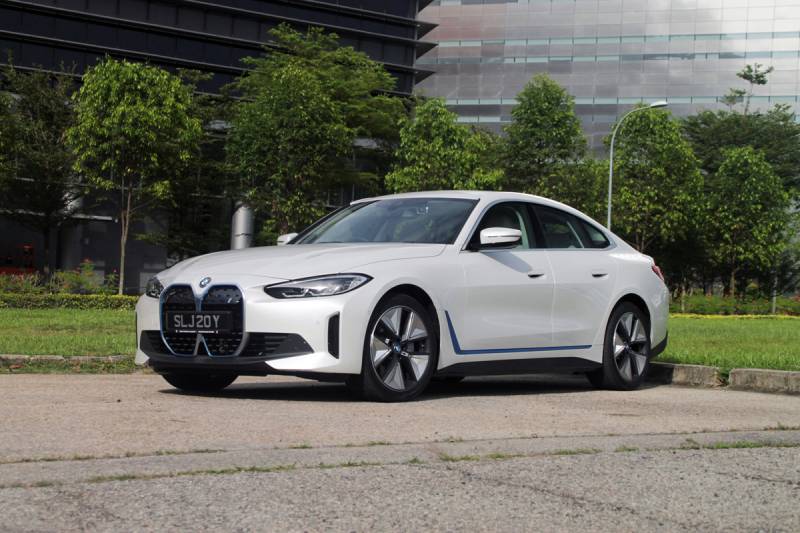
To recap, the number of EV sedans on sale here can be counted on one hand: Audi e-tron GT, Tesla Model 3, Polestar 2, Porsche Taycan and now, the BMW i4.
In simple terms, the i4 is the electric version of the 4 Series Gran Coupe, just as the iX3 is the electric version of the X3 sport utility vehicle (SUV). The 4GC launched in Singapore late last year.
The i4’s official launch date for Singapore: March 25, 2022. The i4 eDrive40 rolled into Performance Motors’ showroom with a price of $311,888 inclusive of Certificate Of Entitlement (COE).
[embed]https://www.youtube.com/watch?v=T-K8VwoWZ_w[/embed]
For those who really care about driving, only the i4 and Tesla Model 3, and the Porsche Taycan have rear-wheel drive versions, but the Taycan is obviously a step above in both size and price terms, and the Tesla is fast and handles well, but it’s still not a driver’s car.
That leaves the i4 as arguably the most driver-focused car in the electric executive sedan segment, at least by BMW’s traditional rule of having the rear wheels push the car and the front ones steer it. But the thing is that it’s simply a great car all round — and not just a good electric sedan.

Because the i4 is a BMW i car foremost, unlike the other four Gran Coupe models it dials back the M-ness, so there’s no M kit on this, the eDrive40. That’s because the M-ness is carried entirely by the more powerful, AWD i4 M50 model.
That’s not a bad thing in our book, since M Sport is traditionally the most popular trim for BMW cars of any type, and if you want an electric BMW you might not be gunning for that anyway.

Overall, we like the fact that it mostly looks like a conventional BMW 4 GC — we cover the design points, including the handle-less doors, in our review of that car. In other words, an attractive four-door coupe/fastback body style that doesn’t scream, “I’m electric!” if you don’t look too closely, and it will appeal to people who don’t want to look like they’re jumping on the electric bandwagon.
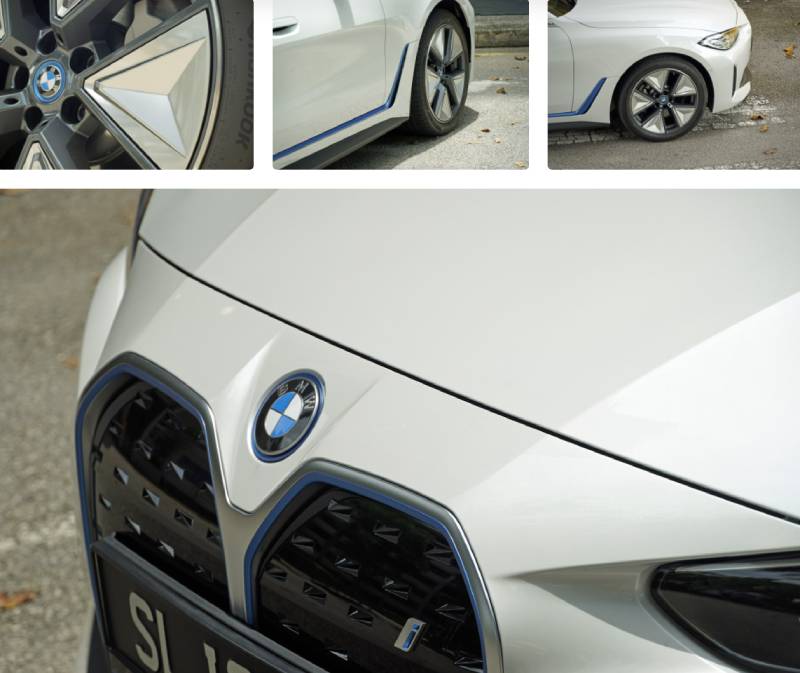
Yet, there is no shortage of BMW i touches, including blue highlights on the badge, grille and rear diffuser, and the L-shaped side-blade running down the length of the car and which you can see more of when you open the doors. Like other EVs, it has a mostly-closed grille and no tailpipes. There’s enough here to let people know you’ve decided to leave combustion behind, without having resorted to doing the obvious thing and buying a Tesla.

The i4 is an interesting case of evolution: While it runs on the BMW CLAR platform (what underpins the 3 Series, 5 Series and more) it has big elements of the next-wave of BMW as embodied by the iX SUV. Contrast this with the iX3, which also uses the CLAR platform, but has the previous infotainment screen/software setup OS 7.
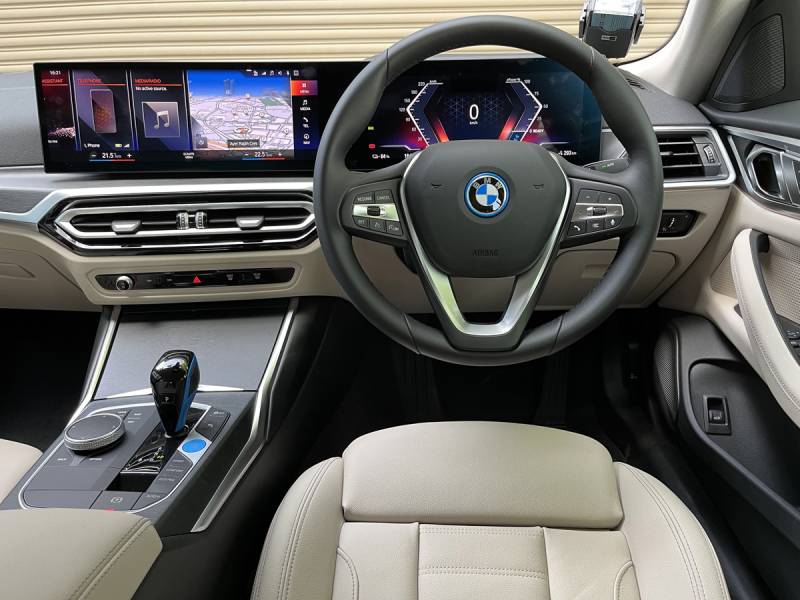
As your eyes travel from the seats and lower console area upward, the cabin goes from familiar to new. Replacing the discrete twin displays is the BMW Curved Display, with the main infotainment screen upsizing from 10.25- to 14.9-inches, while the 12.3-inch driver’s display stays the same.
The big change is now both screens reside behind one curved pane of glass (hence "Widescreen" though it’s not actually one entire display). Because climate control is migrated into the screen, the overall layout looks cleaner than that of the 4GC.
As mentioned in our review of the iX, we’re still getting to grips with OS 8, with the plus points being a polished, modern feel with slick graphics and deep tech integration. The downside is that after years of evolution of iDrive and the classic menu layout nothing is in the ‘right’ place, and the menu icons are uncharacteristically tiny.
Dramatic tech aside, it’s a biggish BMW so the level of fit and finish is typically high, and the equipment list is very good. Active safety is present in spades, with lane departure warning/keeping, forward and rear collision prevention/warning, pedestrian detection, rear cross traffic alerts, speed limit info.

Like the 4GC, the i4 is a five-door fastback, so a wide tailgate with an automatic open feature is great for loading up bulky items. Boot space is the same, at 470 litres, going up to 1,290 litres with the seats (40/20/40) folded down.
READ ALSO: Polestar's Singapore showroom is now officially open
Passenger space is where we suspected the i4 had to trade in some points, and we were right. With the battery occupying the floor of the vehicle, it does feel like a higher perch for the rear passengers with the “EV high knees” effect in play. Headroom is less on the i4 than the 4GC — anyone close to 1.8m tall will brush the ceiling, whose sides also slope inward. Another drawback of the styling: Rear visibility is not very good.

The driving position is still low-slung enough, as fitting a BMW, but the tradeoff here is that if you like sitting low to the ground as a driver, your rear passenger’s feet will have nowhere to go. To sum up, it’s a little less comfortable in the back of the i4, but it’s still perfectly decent for two average-sized people.
BMW’s app-connectivity means you can keep tabs on the car with your phone, and also use your phone’s NFC chip as a car key.
Remember what we said about the i4 being an interesting case? It’s also currently the fastest-charging BMW EV, capable of a DC fast charge rate of 200kW, so it’s actually quicker charging than the iX (150kW). The car’s price includes a Mode 2 charge cable (which is like a giant laptop power supply), and a wallbox.

In conventional ICE car terms, a light, rear-wheel drive sedan has potential to be a good driver’s car. The i4 is, relatively speaking, all of those things: It’s a low-slung sedan with a rear-wheel drive layout, and less massive than an electric SUV of similar size.
No surprise that it’s the best driving EV in its price range/size right now, at least in terms of how it sails around corners.
Like many EVs, it’s easy to drive and a peaceful experience at regular speed, but even at those speeds, the balance and drivability of the car come through. Similar to its brother, the iX3, the i4 has an eager, accurate nose and 'feelsome' steering that make it more enjoyable to drive than some all-wheel drive EVs.

As mentioned, the driving position is low enough that you don’t feel like you’re sitting on a flying mattress/battery pack, and the i4’s balance is particularly good, so much so that you feel the car react around and with you. BMW’s Hans Zimmer-composed synthetic sound isn’t a match for a purring inline six, but it is accurately pegged to your right foot for an additional point of feedback.
Braking doesn’t feel like an afterthought, with good pedal feel and overall stopping power — contrast some particularly heavy EV SUVs which are wonderful at gaining speed, but shedding it is borderline scary.

Those looking to trump others at stoplights should look elsewhere, since the i4 has a modest power output. But its 340hp and not-so-aggro 430Nm of torque actually add to the ease of driving this car quickly, since the power delivery isn’t so abrupt that it throws you off the line when you want to ride the lightning.
And when you do, the i4 doesn’t give up the electric ghost, but stays admirably composed. It’s still not a light car, and like all EVs, you definitely shouldn’t take too many liberties with it, but it’s good and engaging enough that it delivers driving satisfaction to a higher level.
READ ALSO: Porsche hints possible joint projects with Apple
The old adage of “any fool can go fast in a straight line” still holds, but with that said, it’s in corners where the i4’s personality really asserts itself. Like other EVs, it has that feeling of a low centre of gravity with plenty of grip, so you can bomb through bends limited only by prudence and bravery.
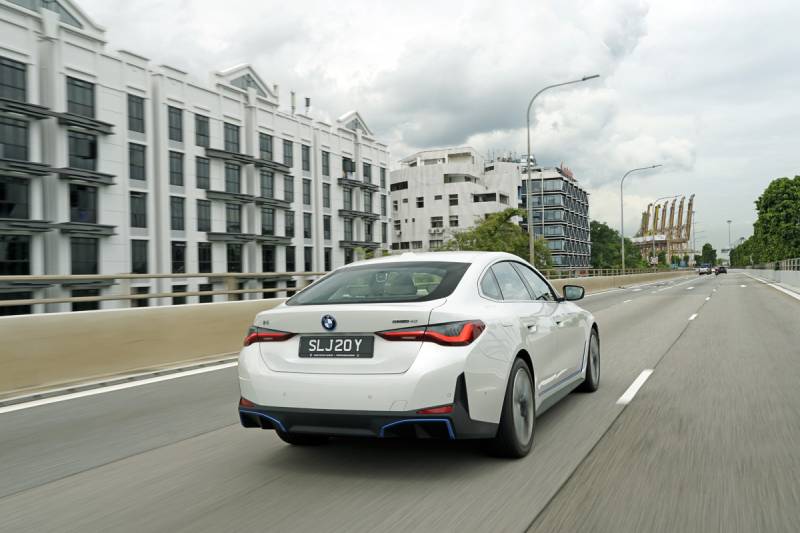
But the i4 is also uniquely adjustable with your right foot. Head in fast, turn the wheel, and trim your line by easing up on the accelerator or widen it by feeding some power in — it’s engaging, exciting and yes, electrifying.
Hit the Sport mode and an artificial whirr starts to pipe up. Silence may add to the novelty of the EV experience, but the i4 reminds you that a pleasant noise that rises in pitch and intensity is one of the sensations we associate with driving fast, and it adds a lot to the BMW’s appeal.
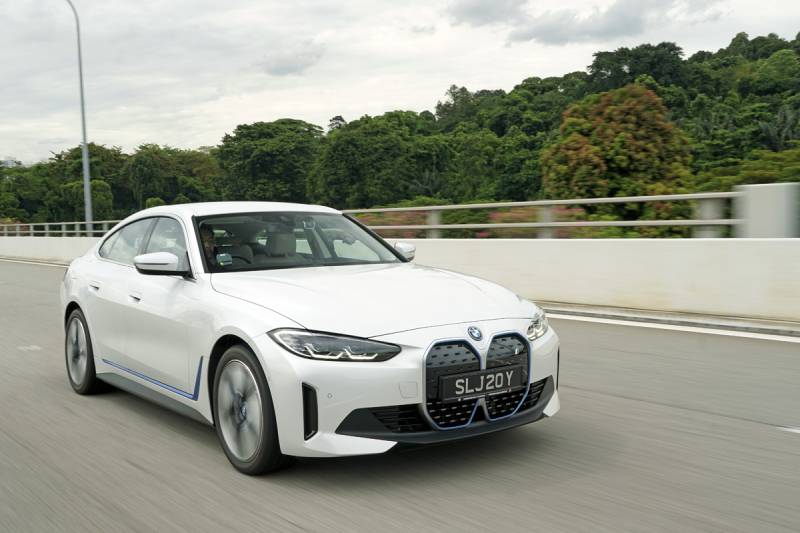
The icing on the lithium cake is that the i4 pairs fun driving with impressive efficiency. After 299km with the i4, it had sipped electrons at 17.6kWh/100km — all the more impressive since Jackrabbit Ju-Len drove most of that distance.
Short A-road runs saw the car run as low as 15kWh/100km. That gives our own range-per-charge at nearly 460km, making it one of the most efficient EVs we’ve tested to date, and easily equal or better to a Tesla Model 3. Matter of fact, we returned the car with 30 per cent left in the battery and 136km of range, according to the trip computer.
All we’ve said about BMW’s fifth-gen electric drive tech being very efficient — like in the iX and iX3 — still holds true, and even more so in a properly aerodynamic fastback bodystyle.

The Tesla Model 3 and Polestar 2 are of a similar size and also have fastback body styles, and are also less expensive. While Polestar has just launched its entry-level model Standard Range Single Motor at $211,000 with COE, the comparable model is the Long Range Single Motor at $227,000 with COE, and the high-performance Long Range Dual Motor at $253,000 with COE.
Tesla’s Model 3 Performance rings in at $160,000 without COE, or around $250,000 with COE, while its mid-tier model the Model 3 Standard Range Plus rings in at just over $200,000 with COE.
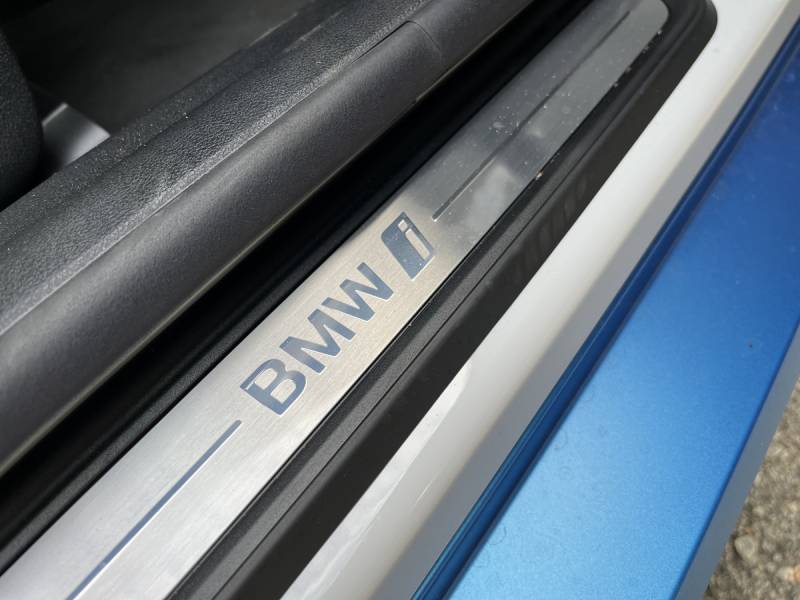
But these cars aren’t, to our eyes, direct competitors: They occupy a premium space, but not a luxury one in the way say, a BMW 3 Series is in direct competition with a Mercedes-Benz C-Class.
For now, there is no other German electric executive sedan — but when we look at the 4 Series GC range itself, the i4 is just like the iX3: Relatively speaking, it’s a bargain and an extremely cost-effective car. It’s priced closer to the 420i GC ($300,000) and but gives you straightline performance comparable to the 430i GC ($350,000).
While it’s not like the iX3 which was the cheapest X3 at launch, it’s certainly worth the money if you compare it to its brethren, as well as other luxury EVs on the market.

BMW’s first electric sedan is everything we expected it to be: It looks good, delivers an involving driving experience, is packed full of tech, and is extremely efficient. The real convincing factor is its cost: In an age where a BMW 320i already costs $300,000 with COE, the i4 makes an extremely strong case for itself. In short, it’s something drivers who want more charge should go for.
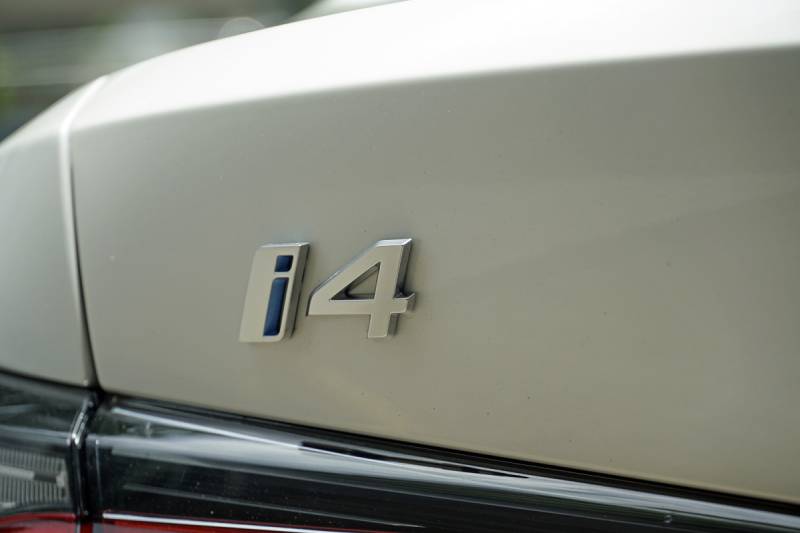
| Drivetrain type | Full electric |
| Electric Motor / layout | Single/Rear |
| Motor power / torque | 340hp/430Nm |
| Battery type /net capacity | Lithium ion, 80.7kWh |
| Normal Charge Type / Time | 11kW AC wallbox/8.5 hours |
| Max Fast Charge Type / Time | 200kW DC/20mins 10 to 80 per cent |
| Electric Range* | 424km average |
| 0-100km/h | 5.7 seconds |
| Top Speed | 190km/h |
| Efficiency* | 19.8 kWh/100km |
| VES Band | A1/ -$15,000 |
| Agent | Performance Motors Limited |
| Price | $312,888 with COE and VES |
| Availability | Now |
| Verdict | BMW’s first electric sedan is brilliant: Nice to drive, tech packed, useful, and very efficient |
READ ALSO: Aston Martin introduces final edition V12 Vantage model
This article was first published in CarBuyer.